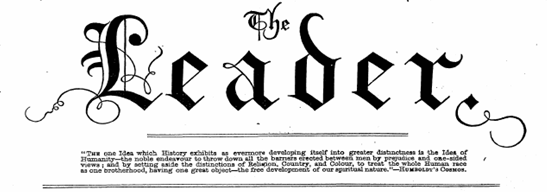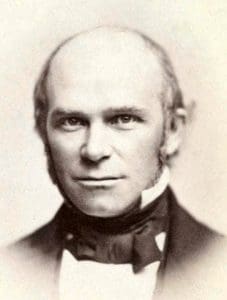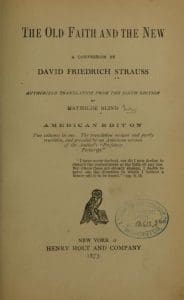
The ‘Scientific Interpretation’ of the Bible and the Warfare of Science with Theology in Christendom
By James C. Ungureanu

In his Autobiography, Charles Darwin (1809-1882) gave three specific reasons for his growing religious doubts. He became morally revolted by the God of the Old Testament, whom he characterised as a “revengeful tyrant.” Moreover, the discovery of the “fixed laws of nature” made belief in miracles seem “incredible” to him. Finally, he concluded that recent historical-critical scholarship—or biblical criticism—demonstrated that the Gospels were completely unreliable. These alleged difficulties gradually led Darwin to “disbelieve in Christianity as a divine revelation.” (1)
Among scholars of the Victorian period, much has been written on the so-called “moral critique” of Christianity and the “crisis of faith.” But few have examined the complex relationship between the rise of biblical criticism and the Victorian conflict between science and religion.(2) Darwin, for instance, was surrounded by friends interested in biblical criticism.(3)
Most historians of science are not biblical scholars. It is perhaps for this reason they have overlooked how important biblical criticism was in the formation of ideas found in some of the work of Darwin’s closet friends and strident supporters, among them the leading “scientific naturalists” of the Victorian age, biologist Thomas H. Huxley (1825-1895), physicist John Tyndall (1820-1893), and evolutionary philosopher Herbert Spencer (1820-1903).
All three, for instance, were avid readers of the radical weekly newspaper, the Leader (1850-1860). Beginning publication in March of 1850, the Leader was edited by Chartist Thornton Leigh Hunt (1810-1873) and literary critic George Henry Lewes (1817-1878), and financially supported by liberal clergyman Edmund R. Larken (1809-1895). As literary scholar Rosemary Ashton has observed, the Leader promulgated “a larger Christian liberalism than then existed.”(4) Each title page of the weekly began with a quote from naturalist explorer Alexander von Humboldt’s (1769-1859) multi-volume Cosmos: A Sketch of a Physical Description of the Universe (1845-62):
The one Idea which History exhibits as evermore developing itself into greater distinctness is the Idea of Humanity—the noble endeavour to throw down all the barriers erected between men by prejudice and one-sided views; and by setting aside the distinctions of Religion, Country, and Colour, to treat the whole Human race as one brotherhood, having one great object—the free development of our spiritual nature.
Part of an aspiring German romantic movement, Humboldt’s book shocked many readers because he spoke of Creation without reference to a Creator. Nevertheless, the editors of the Leader praised his developmental view of the spiritual nature of man, and actually used it as a weapon against radicals, materialists, and others who promoted a Godless universe.
Obviously, then, the contents of the Leader were not atheistic. The editors of the weekly, however, did speak of a “New Reformation” in religion, one that would bring humanity one step closer to fulfilling—and, indeed, completing—the Protestant Reformation of the sixteenth century.(5) As a “protest” movement, then, the Leader was particularly fond of historical-critical approaches to the Bible and early Christianity. In its decade long run, the Leader published numerous articles and reviews of dissident intellectuals Robert William Mackay (1803-1882), William R. Greg (1809-1881), and Charles Hennell (1809-1850), among others. In their work, these thinkers argued that “the hypothesis of miracle has lost its usefulness.” But this should not lead to atheism. A “perfect and immutable being,” they argued “cannot break his own laws, or be at variance with himself.” Moreover, some of them even contended that “religion and science are inseparable,” and called for a “higher view of religion.”
All these ideas were influenced by German Protestant historians and biblical scholars. “The German theological professors,” the editors of the Leader wrote, “are proverbially prodigies of learning.” German scholars such as Friedrich Christoph Schlosser (1776-1861), Karl Gottlieb Bretschneider (1776-1848), Augustus Neander (1789-1850), and Friedrich D. E. Schleiermacher (1768-1834) were praised in its pages as among the highest “religious teachers and reformers” of the century.

Source: Wikimedia (Public Domain)
It should be no surprise, then, that the Leader also praised the American “New Theology” movement, led by figures such as Horace Bushnell (1802-1876) and Theodore Parker (1810-1860).The pervading character of this movement, the editors observed, is a “protest more or less vigorously against the principle of religious dogmatism.” Bushnell was one such champion of a “freer theology,” while Parker presented a “religion for our age.”
The Leader folded in 1860. But the scientific naturalists Huxley, Tyndall, and Spencer were so impressed by its contents that when they took over the literary journal, the Reader in 1864, they adopted a similar style and content. While the Reader would eventually transform into the scientific journal Nature, in its early pages it provided a unique combination of multiple literary traditions: scientific, religious, and social criticism. Indeed, most striking to modern eyes is its dedication to publishing reviews and essays on the latest biblical scholarship.
Established in 1863 by the Christian socialists J. M. Ludlow (1821-1911) and Thomas Hughes (1832-1917) and astronomer Joseph Norman Lockyer (1836-1920), who were themselves inspired by the writings of Broad Churchman Frederick D. Maurice (1805-1872), the magazine was soon acquired by the “young guard” of scientific naturalism. Beginning in 1864, Huxley and Tyndall started serving as its science editors and Spencer as its editor of content on philosophy, psychology, and theology. Despite this takeover, the Reader remained a “liberal alliance,” as the historian of science Ruth Barton put it.[6] In its pages, the Reader heaped praises on the controversial Essays and Reviews (1860), John William Colenso’s (1814-1883) The Pentateuch and the Book of Joshua Critically Examined (1862), Robert W. Mackay’s (1803-1882) Tübingen School and its Antecedents (1863), and Henry Hart Milman’s (1791-1868) History of the Jews (1863).
And like the Leader before it, the Reader gave glowing praise to American New Theologian, Theodore Parker. Parker’s chief characteristic, according to the Reader, was the fact that he “more completely denied a supernatural revelation than any one else has done” and yet “cared to retain the name of Christian.” The Reader also retroactively proclaimed mathematician and Church of England clergymen Baden Powell’s (1796-1860) Christianity without Judaism an “antidote to the teaching of the extreme sections of the Christian Church in England.” First published in 1856, Powell—who, incidentally, was also one of the contributors of the controversial Essays and Review of 1860—argued for an evolutionary view of Christian doctrine. This was an extremely popular view among German thinkers at the time.
Finally, it should be said that both the Leader and Reader celebrated the advent of a naturalistic “lives of Jesus” genre emerging mid-century, which attempted to portray Jesus of Nazareth as only human. Both weeklies commented on numerous biographies of Christ, including David Friedrich Strass’s (1808-1874), Life of Jesus (1835), Joseph Ernest Renan’s (1823-1892) La Vie de Jésus (1863), and John Robert Seeley’s anonymous Ecce Homo: A Survey of the Life and Work of Jesus (1865), to mention just a few. (7)
While much more can be said about the Leader and the Reader, it should now be clear that the scientific naturalists were well-informed about the latest and greatest in historical-critical scholarship of the Bible and early Christianity. To pick out just one representative example, it is often forgotten that Huxley was “much more a literary than a scientific man,” as G. K. Chesterton once quipped. (8) Huxley claimed he was “brought up in the strictest school of evangelical orthodoxy,”(9) and often talked about his love of the Bible as a child.(10) Despite his later agnosticism, Huxley continued to acknowledge the Bible’s central position in Victorian life and was among those who argued for its use in state schools.(11)
In the 1880s, Huxley seemingly abandoned scientific research altogether and embarked on a late, second career as a biblical critic. He even intended to write and deliver “Working-Men’s Lectures on the Bible.”(12) Biblical criticism, as historian Adrian Desmond put it, became Huxley’s cheval de bataille.(13) In 1884 Huxley told English physiologist Michael Foster (1836-1907) that “I am principally occupied in studying the Gospels.”(14) Indeed, biblical studies dominated his thoughts and writing from 1885 until his death a decade later.

While he never completed his “lectures on the Bible,” Huxley did compose a series of connected and complimentary essays in the period 1885-91, most of which were published in the Nineteenth Century magazine. These essays and others were compiled in a massive 625-page volume entitled Essays Upon Some Controverted Questions (1892). The prefaces and prologues to his Collected Essays (1892-94) also provide ample evidence of the influence of biblical criticism. Indeed, in the very beginning of one volume, Huxley gives a long quote from Strauss’s later 1872 work, Der alte und der neue Glaube (“The Old Faith and the New”), referring to him approvingly as “one of the protagonists of the New Reformation,” and thus sees in him a kindred spirit.(15)
Besides Huxley and his coterie, the so-called “cofounders” of the “conflict thesis,” the idea that science and religion are fundamentally and irrevocably in conflict or at war, were greatly influenced by the rising tide of biblical criticism. Historians of science have typically traced the origins of the thesis to University of New York chemist John W. Draper’s History of the Conflict between Religion and Science (1874) and first President of Cornell University Andrew D. White’s A History of the Warfare of Science with Theology in Christendom (1896). But as I demonstrate in my recent book, Science, Religion, and the Protestant Tradition, Draper and White did not argue for a conflict between “science and religion.”(16) Indeed, for both Draper and White the conflict was between two contending theological traditions—namely, a more progressive, liberal, and diffusive Christianity and a more traditional, conservative, and orthodox Christianity. (17)
It is in fact untenable to read Draper and White and not consider their debt to historical-critical scholarship. This is especially true in reading White’s magnum opus. In his last and longest chapter in A History of the Warfare, White describes in striking detail the “laws governing the evolution of sacred literature,” offering essentially what biblical scholar and theologian Hans Frei has put in another context as, “an analysis of analyses of the Bible.”(18) White ranged over the history of the “scientific interpretation” of the Bible, mentioning its precursors such as Hugo Grotius (1583-1645), Isaac La Peyrère (1596-1676), Baruch de Spinoza (1632-1677), Richard Simon (1638-1712), Jean Leclarc (1657-1736), Richard Bentley (1662-1742), Jean Astruc (1684-1766), Robert Lowth (1710-1787) and others. He praised the contributors to the Essays and Review for effectively “entering wedges into the old tradition,” and even claimed that Renan’s La Vie de Jésus ushered “a new epoch.”(19) But for White, the “scientific interpretation” of the Bible provided “new solution to those problems which dogmatic theology has so long laboured in vain to solve.”(20)
Near the end of the century, a writer for the politically liberal Speaker believed that:
[N]othing is more remarkable than the ubiquity of the question as to criticism and the authority of the Scriptures. It is in all the Churches, and with impartial thoroughness vexes all. It puzzles the infallibility of Rome, breaks the unity of the High Anglicans, agitates the stern and unbending Presbyterians, disturbs the peace of the Independents, invades the philosophic calm of those scientific and agnostic souls who are the jealous guardians of the truth and ever on the watch for the slips of men simple minded enough to be subtle. (21)
While biblical criticism was “everywhere,” it was not necessarily anti-religious. No. In fact, many of the founders of the discipline saw themselves as reformers of religion rather than its opponents. But how these reformers defined “religion” mattered a great deal. Indeed, the rise of biblical criticism is a good example of historical irony. Historical criticism of the Bible originated in the opposition between church dogma and the new liberal political philosophy of emergent modern Europe. Proponents of the new criticism viewed the Bible as a fully human (i.e., natural) product and began to study it as they would any ordinary ancient text, without recourse to explanations that invoked miracles or prophecy. Combined with this naturalistic explanation of the origins of religion, was a conception of history that evolutionary ideas greatly abetted. Historical events, accordingly, were always conditioned by what had gone before, and religious consciousness, where it existed, was simply the reflection of a given time and place. This, in turn, would lead many to a concerted effort to uncover the original message of Jesus separate from church tradition. According to Frei, “modern theology began in England at the turn of the seventeenth and eighteenth century,” particularly among the English deists, who were neither atheists nor even agnostics but promoters of a more “rational Christianity” or “natural religion.”
What I have emphasized here is the central role biblical criticism played in how nineteenth-century thinkers redefined “religion,” and, ultimately, how that, in turn, defined their understanding of the relationship between religion and science. For White, modern science, natural and historical, has acted powerfully to “dissolve away the theories and dogmas of the older interpretation.” Thanks to “the labours, sacrifices, and even the martyrdom of a long succession of men of God,” the Bible had been released from “a mass of entangling utterances,” fruitless “wrangling interpretations,” “fetichism, subtlety, and pomp,” and “everything which the Lord Jesus Christ most abhorred.”. According to White, our understanding of “sacred literature” had grown under the “divine light which the various orbs of science” provide, which has “done so much to bring into the mind and heart and soul of man…an exposition, not of temporary dogmas and observances, but of the Eternal Law of Righteousness—the one upward path for individuals and for nations.” (22)
More than any other proponent of the so-called “conflict thesis,” White offered readers the most detailed survey of the ways in which biblical scholarship had been read and understood from the formation of the Septuagint to the end of the nineteenth century. Whatever its shortcoming (and there are many), White offered readers a glimpse of how men like himself attempted to reconcile the growing sense of separation between reason and faith, science and religion. In short, if we are to make sense of the nineteenth-century “conflict thesis,” what it was, what it is, and what it may still happen to be, we need to put nineteenth-century narratives of science and religion within the history of modern biblical interpretation.

Dr James C. Ungureanu is an intellectual historian with a particular interest in the history of religious thought. His most recent book, Science, Religion, and the Protestant Tradition: Tracing the Origins of Conflict (University of Pittsburgh Press, 2019), offers a new interpretation of the “conflict thesis,” the idea that science and religion are fundamentally at odds. For more see his Researcher Profile.
[1] The Autobiography of Charles Darwin, 1809-1882 (New York: W.W.Norton & Company, 1958), 86
[2] John Hedley Brooke, in his classic Science and Religion: Some Historical Perspectives (Cambridge: Cambridge University Press, 1991), very briefly discussed “the wider context of biblical criticism,” but did not sufficiently show the connection and influence of biblical criticism on leading figures of the Victorian science and religion debate (357-73)
[3] See Adrian Desmond and James Moore, Darwin: The Life of a Tormented Evolutionist (New York: W. W. Norton & Company, 1994), 216
[4] See Rosemary Ashton, G. H. Lewes: A Life (Oxford: Clarendon Press, 1991), 88
[5] On the concept of the “New Reformation,” see my “Science, Religion and the ‘New Reformation’ of the Nineteenth Century,” Science & Christian Belief, 31.1 (2019): 46-61
[6] Ruth Barton, The X Club: Power and Authority in Victorian Science (Chicago: University of Chicago Press, 2018), 202
[7] On Seeley, see the recent volume by Ian Hesketh, Victorian Jesus: J. R. Seeley, Religion, and the Cultural Significance of Anonymity (Toronto: University of Toronto Press, 2017)
[8] G. K. Chesterton, The Victorian Age in Literature (London: Williams and Norgate, 1913), 39
[9] Thomas H. Huxley, Essays upon some Controverted Questions (London: Macmillan and Co., 1892), 346
[10] Thomas H. Huxley, Collected Essays,Science and Education, vol. 3 (London: Macmillan and Co., 1894), 213
[11] See discussion in Timothy Larsen, A People of One Book: The Bible and the Victorians (Oxford: Oxford University Press, 2011), 196-218
[12] Leonard Huxley, Life and Letters of Thomas Henry Huxley, 3 vols. (London: Macmillan and Co., 1908), 3.279-80
[13] Adrian Desmond, Huxley: From Devil’s Disciple to Evolution’s High Priest (Reading, MA: Helix Books, 1997), 571
[14] Huxley, Life and Letters, 2.362
[15]Thomas H. Huxley, Collected Essays, Science and Education, vol. 5 (London: Macmillan and Co., 1894), v-vi
[16] James C. Ungureanu, Science, Religion, and the Protestant Tradition: Retracing the Origins of Conflict (Pittsburgh: University of Pittsburgh Press, 2019)
[17] Incidentally, historian Bernard Lightman has also challenged conventional interpretations of the scientific naturals, arguing that “there were many vestiges of traditional religious thought embedded in Victorian agnosticism” and has even suggested that “agnosticism originated in a religious context.” See his The Origins of Agnosticism: Victorian Unbelief and the Limits of Knowledge (Baltimore: Johns Hopkins University Press, 1987)
[18] Hans W. Frei, The Eclipse of Biblical Narrative: A Study in Eighteenth and Nineteenth Century Hermeneutics (New Haven: Yale University Press, 1974), vii
[19] Andrew Dickson White, A History of the Warfare of Science with Theology in Christendom, 2 vols. (New York: D. Appleton and Co., 1896), 2. 342, 360
[20] White, A History of the Warfare., 2.394
[21] “The Churches and the Scriptures,” Speaker, vol. 3 (Jun 20, 1891): 724-25.
[22] White, A History of the Warfare, 2.394, 395.
